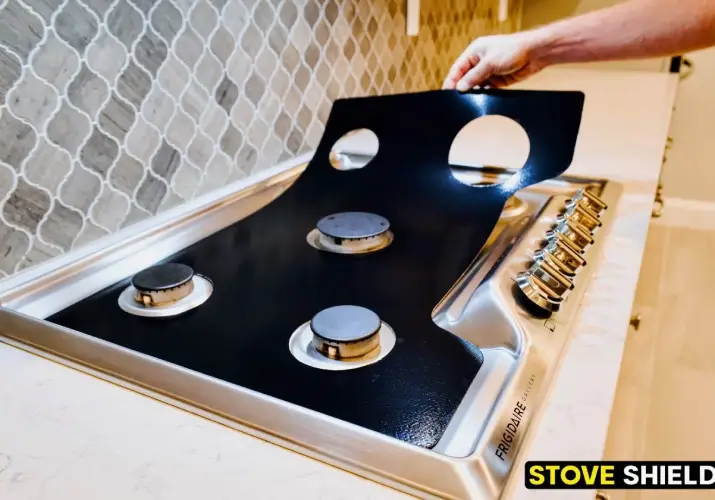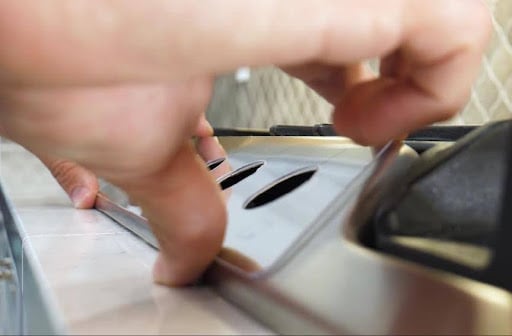Stove glass is a standard feature in many modern gas, electric, and wood-burning stoves, offering both functionality and aesthetic appeal. It allows users to monitor food or flames without opening the appliance, helping maintain heat and ensuring safety during cooking or heating.
However, a common concern among homeowners is: Can stove glass break from heat? While stove glass is engineered to withstand high temperatures, it’s not immune to damage—especially under certain conditions.
In this article, we’ll explore the primary causes behind heat-related stove glass breakage, the safety risks involved, and the most effective ways to prevent it. We’ll also introduce protective solutions like Stove Shield, designed to enhance stove safety and extend the life of your appliance.
Understanding Stove Glass: What Is It Made Of?
Stove glass isn’t just any ordinary glass—it’s specially engineered to handle extreme temperatures while maintaining safety and clarity. Depending on the type of stove or appliance, manufacturers typically use one of two materials: tempered glass or ceramic glass.
- Tempered Glass: Commonly found in oven doors and glass cooktops, tempered glass is heat-treated to improve strength and thermal resistance. It can typically withstand temperatures up to 600°F (315°C). If it breaks, it shatters into small, less dangerous pieces, reducing the risk of injury.
- Ceramic Glass: Used in wood-burning, pellet, and some high-heat gas stoves, ceramic glass can tolerate extreme temperatures of up to 1400°F (760°C) or more. Unlike tempered glass, it doesn’t expand and contract significantly, making it ideal for direct flame contact and prolonged high-heat exposure.
These materials are chosen specifically for their thermal shock resistance, durability under stress, and optical clarity, allowing users to view flames or food safely and efficiently. Understanding what your stove glass is made of helps explain both its resilience—and its limitations—under intense heat.
Can Stove Glass Actually Break from Heat?
Yes—stove glass can break from heat, but it typically happens under specific, avoidable conditions. While high-quality stove glass is built to endure extreme temperatures, certain scenarios can push it beyond its limits.
Here are the most common causes of heat-related breakage:
- Thermal Shock: The most frequent culprit. Rapid temperature changes—like pouring cold water on a hot glass cooktop—can cause the glass to expand or contract unevenly, leading to cracks or full breakage.
- Uneven Heating or Flame Impingement: If a burner flame directly contacts the edge of the glass or one area heats significantly faster than another, stress fractures can occur over time.
- Poor Quality or Worn-Out Glass: Inferior materials or aged glass lose their thermal resistance, becoming more vulnerable to heat-related stress.
- Manufacturing Defects or Incorrect Installation: Even a slight flaw or improper fitting can create weak points that may crack under pressure or intense heat.
Real-World Examples Include:
- Splashing cold liquids on a hot glass stove top
- Using oversized cookware that reflects and traps excess heat
- Allowing burner flames to lick the edge of the glass, especially on gas ranges
While stove glass is durable, these conditions can lead to unexpected breakage. That’s why proper usage and preventive care are essential for maintaining safety and performance.
Common Causes of Stove Glass Breakage
Stove glass is tough—but not indestructible. Over time or under the wrong conditions, several factors can weaken or break even the most heat-resistant glass. Here are the most common causes:
- Thermal Shock: Sudden changes in temperature—like splashing cold water on a hot glass surface or placing a frozen pan on a hot cooktop—can cause rapid expansion or contraction, leading to cracks or shattering.
- Impact Stress: Dropping heavy cookware, banging pots, or accidentally striking the glass with utensils can create chips, fractures, or full breakage. Even small impacts can cause long-term damage if not addressed.
- Internal Pressure Buildup: In ovens and stoves, pressure from steam or trapped heat—especially if a door gasket or seal fails—can strain the glass, making it more prone to cracking or bursting.
- Wear Over Time: Everyday use can lead to micro-scratches and surface damage. When exposed repeatedly to high heat, these minor imperfections can worsen, eventually turning into cracks.
- Low-Quality Aftermarket Replacements: Not all glass replacements are created equal. Non-certified or low-quality glass that isn’t rated for high temperatures is far more likely to fail under heat stress.
Understanding these causes helps highlight the importance of proper use, routine maintenance, and quality materials—key steps for preventing glass failure and keeping your kitchen safe.
Warning Signs Before Glass Breaks
Stove glass rarely breaks without warning. In many cases, there are early signs of stress or damage that, if noticed in time, can help prevent a dangerous situation. Here are the most common warning indicators to watch for:
- Fine Cracks or Starburst Fractures: Hairline cracks that resemble spiderwebs or starburst patterns often start small but can quickly spread when exposed to heat.
- Cloudy or Discolored Areas: If parts of the glass appear hazy, scorched, or discolored, it may signal heat stress or surface degradation—early signs that the glass is weakening.
- Chips on Edges or Corners: The perimeter of stove glass is its most vulnerable area. Even small chips can turn into major cracks, especially under the pressure of high temperatures.
- Warping or Bulging: Any distortion in the shape of the glass indicates severe thermal stress or internal pressure, and it often precedes breakage.
- Unusual Heat Patterns or “Hot Spots”: If one area of the glass gets noticeably hotter than the rest, it may indicate uneven heating or a failing seal—both of which can stress the glass over time.
Recognizing these early warning signs gives you the chance to act—whether by replacing the glass, inspecting seals, or using protective products like Stove Shield—before a minor issue becomes a major safety hazard.
Safety Risks When Stove Glass Breaks
When stove glass fails, it’s more than just an inconvenience—it can pose serious safety risks to you, your kitchen, and your appliance. Here’s what can happen if stove glass breaks during use:
- Burn Injuries from Hot Shards: Broken stove glass can shatter into dangerously hot fragments. If touched or stepped on, these shards can cause severe burns or cuts—especially risky if children or pets are nearby.
- Fire Hazards: On a cooktop, broken glass can allow liquids, oils, or food to spill directly onto burners or internal electrical components, increasing the risk of short circuits, flare-ups, or even kitchen fires.
- Appliance Damage: A shattered glass top or oven window can lead to burner malfunctions, warped frames, or damaged insulation. In ovens, a broken seal can reduce efficiency and expose internal components to harmful heat.
- Voided Warranties: Most manufacturers specify proper care requirements. If breakage occurs due to misuse, neglect, or aftermarket parts, it could void your appliance warranty, leaving you with full repair or replacement costs.
Preventing glass failure isn’t just about avoiding inconvenience—it’s about protecting your home, health, and investment. That’s why proactive care and using protective solutions like Stove Shield are so important.
How to Prevent Stove Glass from Breaking
While stove glass is designed for durability, following smart practices can significantly reduce the risk of cracks, chips, or catastrophic breakage. Here’s how to keep your stove glass safe and long-lasting:
Best Practices for Stove Use
- Avoid Sudden Temperature Changes
Never pour cold water or place frozen items on a hot glass surface—this can cause thermal shock and cracking. - Use Flat-Bottom Cookware
Cookware with uneven or warped bottoms can create hot spots that stress the glass. Stick to flat-bottom pots and pans for even heat distribution. - Control Heat Levels
Use low to medium heat for most cooking. Only use high heat when absolutely necessary (like boiling water or searing meat). - Clean Glass Surfaces Regularly
Built-up residue can trap heat and cause uneven cooking temperatures. Use non-abrasive cleaners to prevent scratches and damage.
Physical Protection Tips
- Avoid Placing Heavy Objects on Glass
Never rest cast iron pans, cutting boards, or other heavy items directly on the glass cooktop. - Don’t Drag Cookware
Always lift pots and pans instead of sliding them across the surface to avoid scratching or chipping the glass. - Match Cookware to Burner Size
Using oversized cookware that overhangs the burner can trap excess heat around the edges of the glass, increasing stress and risk of breakage.
Use Heat-Resistant Stove Top Protectors (Like Stove Shield)
- High-Performance Materials
Stove Shield protectors are made with PTFE-coated fiberglass, designed to withstand high temperatures and act as a barrier between cookware and glass. - Diffuse and Absorb Heat
These protectors help distribute heat more evenly—especially useful when using large or irregularly shaped cookware. - Protect Against Scratches and Cracks
By minimizing direct contact and friction, Stove Shield helps reduce wear and tear that weakens glass over time. - Easy to Clean and Reusable
Stove Shield protectors are non-stick, dishwasher-safe, and simple to maintain—making them a smart, cost-effective solution for glass cooktop protection.
Taking these preventive steps—along with using a Stove Shield—can help safeguard your stove glass, improve cooking performance, and extend the life of your appliance.
What to Do If Stove Glass Cracks or Shatters
If your stove glass cracks or shatters, safety comes first. Acting quickly and correctly can prevent injury, further damage, or fire risks. Here’s what to do:
- Turn Off the Stove Immediately
Shut off all burners or the oven as soon as you notice a crack or hear the glass break. This prevents further heat stress and minimizes danger. - Allow the Appliance to Cool Completely
Do not touch or clean the area until the stove or oven has cooled down fully. Hot glass fragments can cause burns or worsen breakage if disturbed. - Do Not Attempt to Cook Again Until Repaired
Using a stove with broken glass is unsafe. Heat exposure can spread cracks, and broken seals can affect cooking performance and safety. - Contact the Manufacturer or an Authorized Service Center
Always replace the broken glass with OEM-certified parts. Professional service ensures proper installation and restores your appliance’s safety features. - Avoid Generic or Non-Heat-Rated Glass Panels
Never try to patch or replace stove glass with regular glass. Only high-temperature-rated, manufacturer-approved materials are safe for use.
Dealing with a cracked cooktop or oven door may be frustrating, but following the right steps ensures your safety and the long-term functionality of your appliance.
Conclusion
Stove glass can indeed break from heat—especially when exposed to thermal shock, heavy impact, or uneven heat distribution. While it’s built to handle high temperatures, misuse or neglect can weaken its integrity over time.
The key to prevention lies in responsible cooking practices, gentle handling, and avoiding sudden temperature changes. For added protection, using a heat-resistant stove top cover like Stove Shield can help diffuse heat, prevent scratches, and extend the life of your cooktop or oven glass.
If you notice cracks, chips, or warping, don’t ignore them. Take immediate action to avoid serious safety risks and expensive appliance damage. A little care today can save you from a dangerous and costly situation tomorrow.
Disclaimer: All information contained within this article is for informational purposes. always refer to your specific stove manual for safety and use instructions and guidance.


